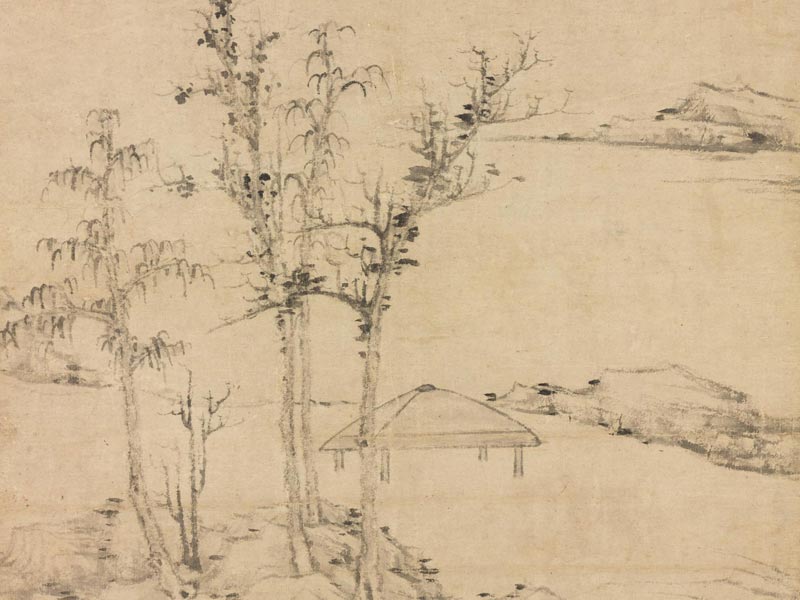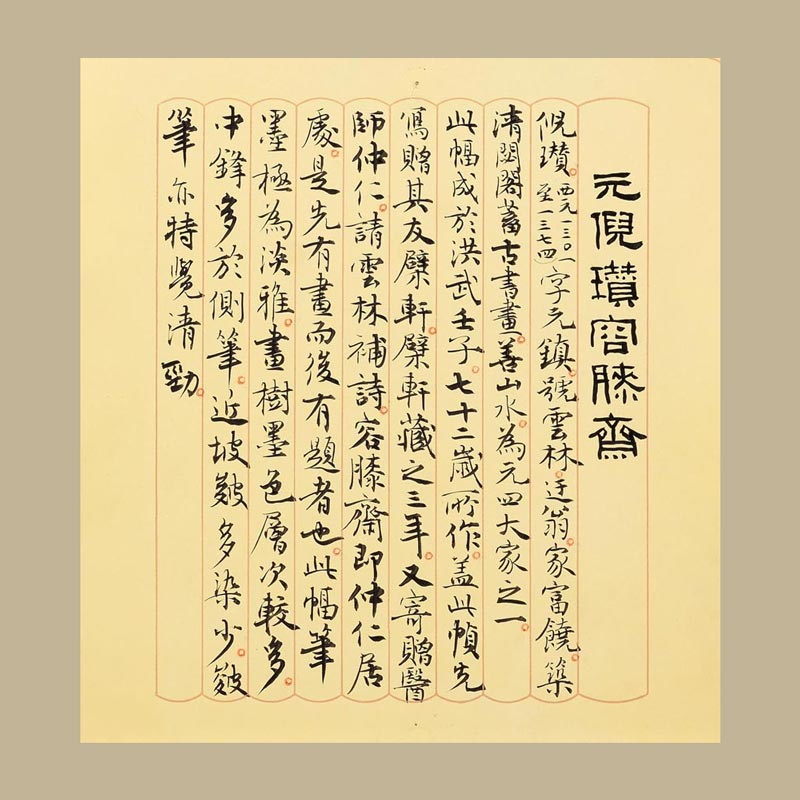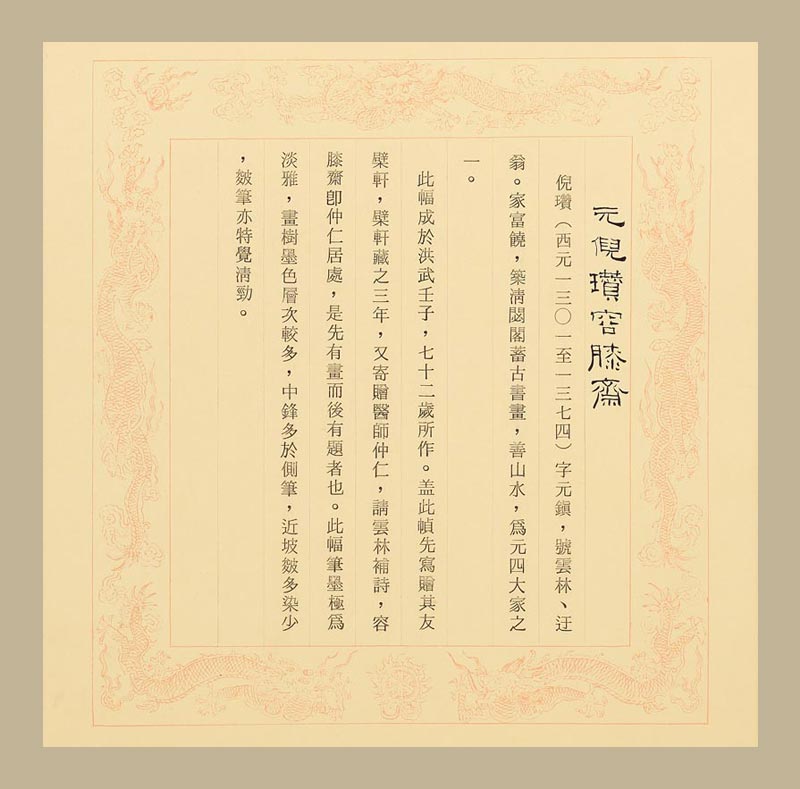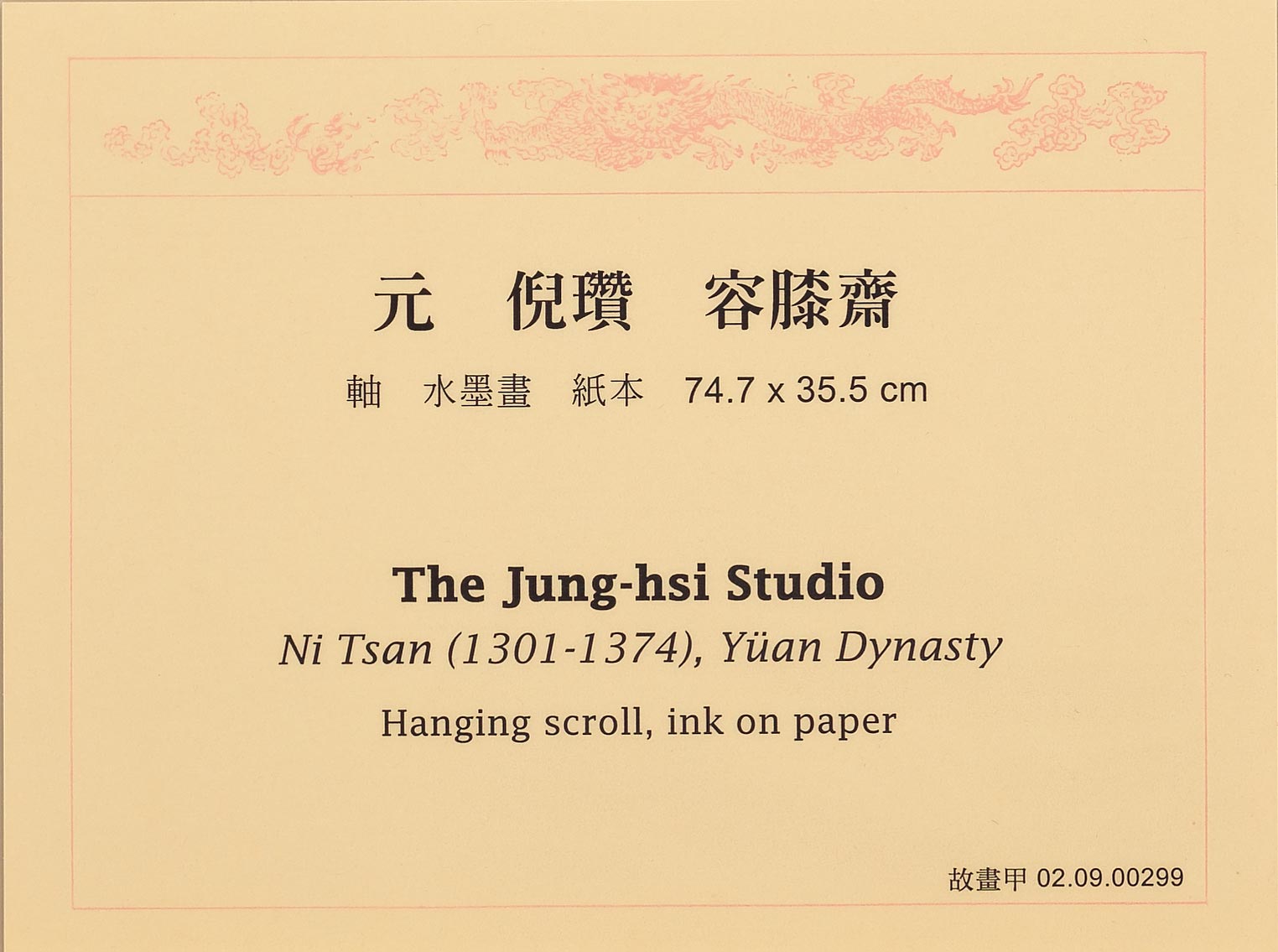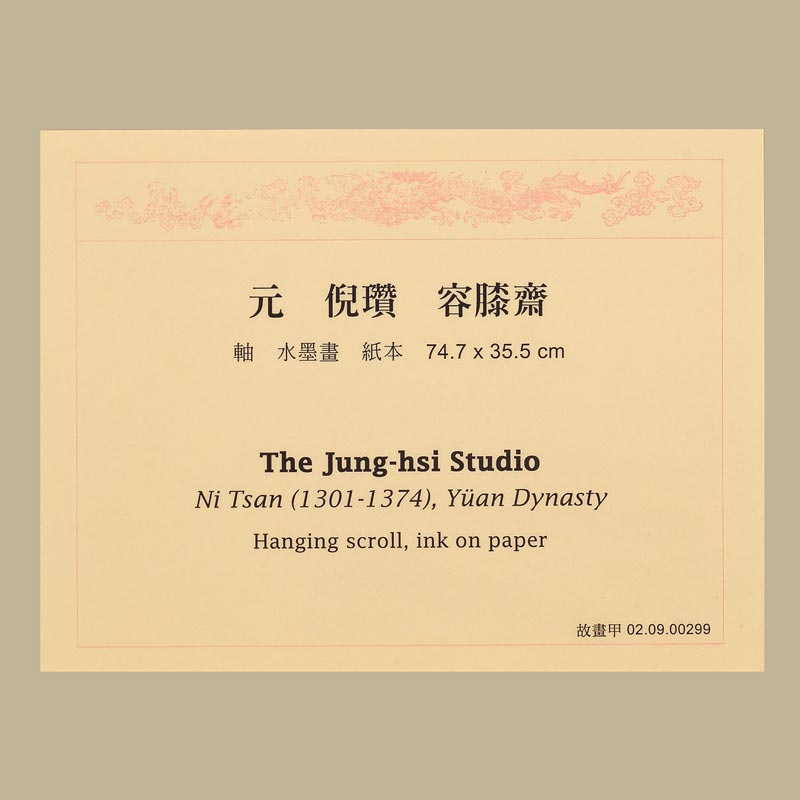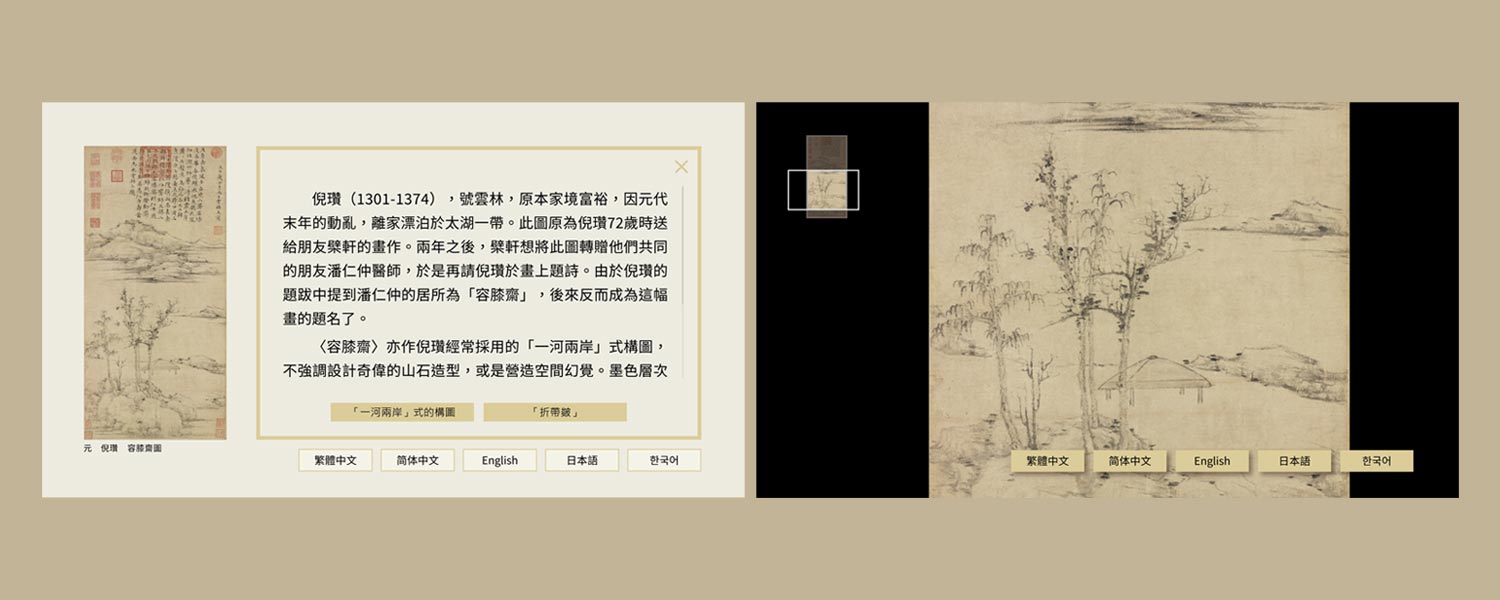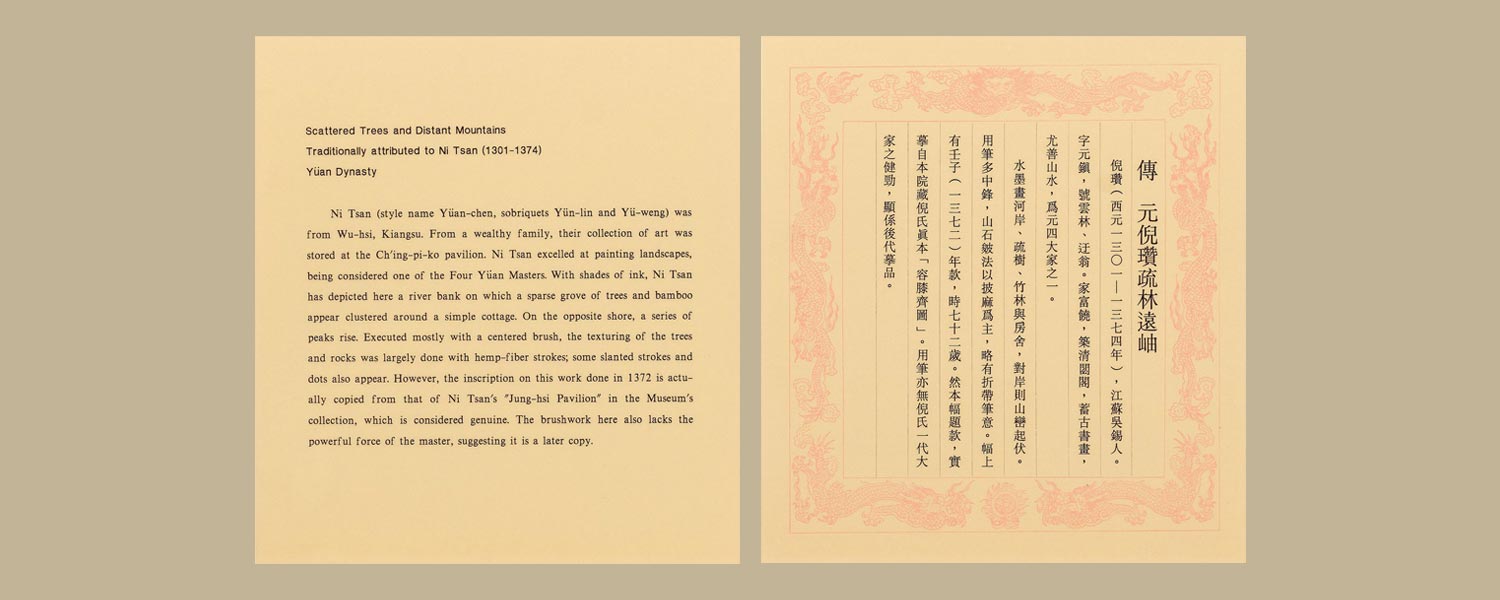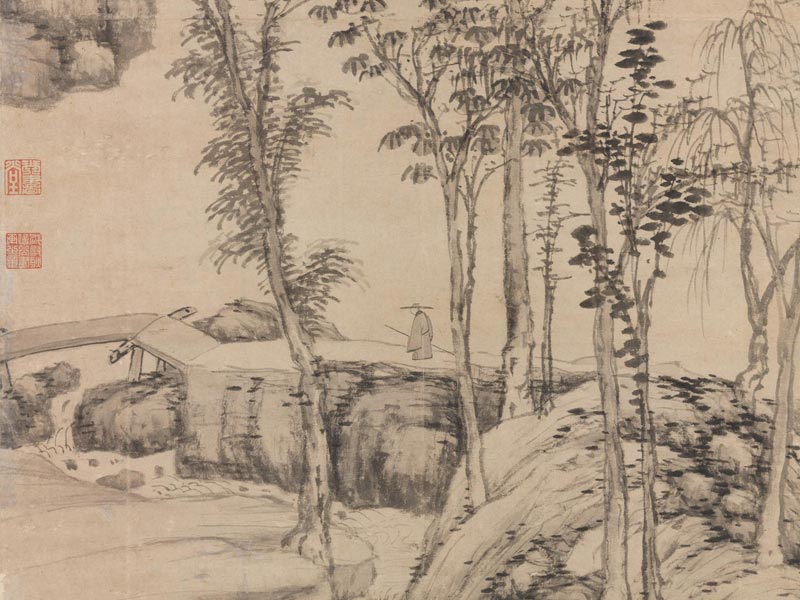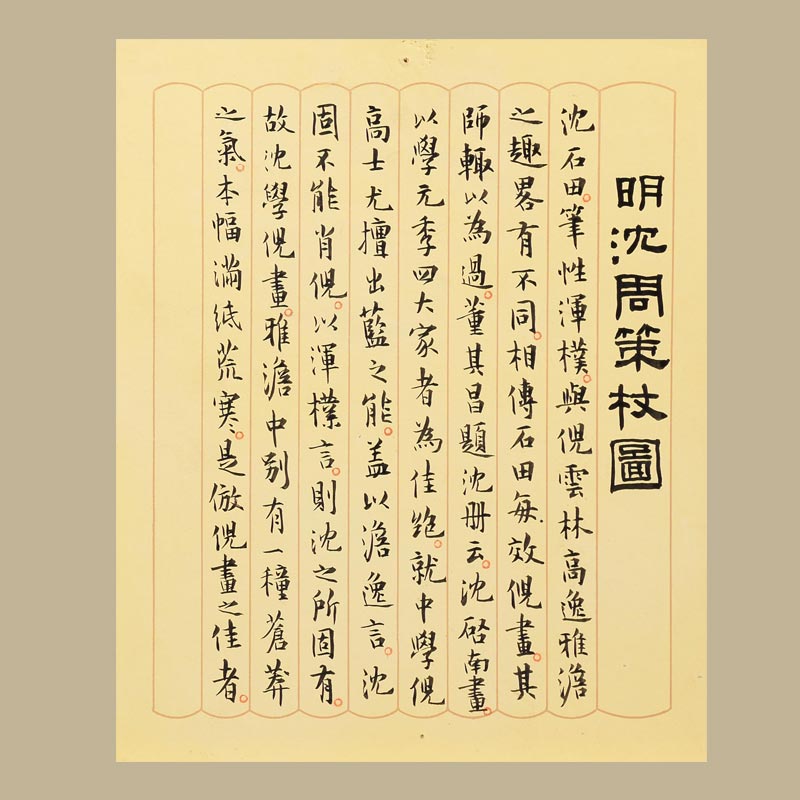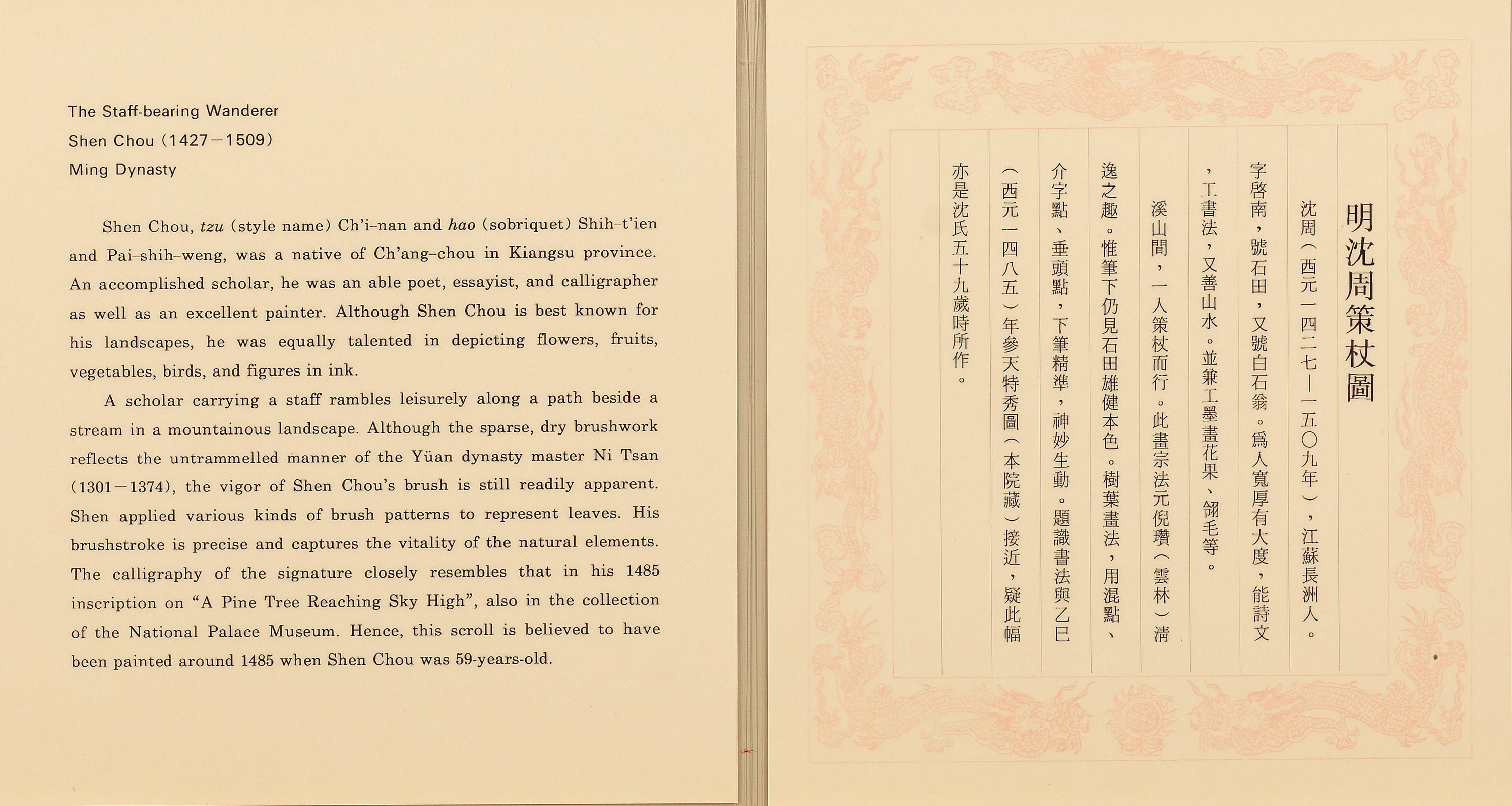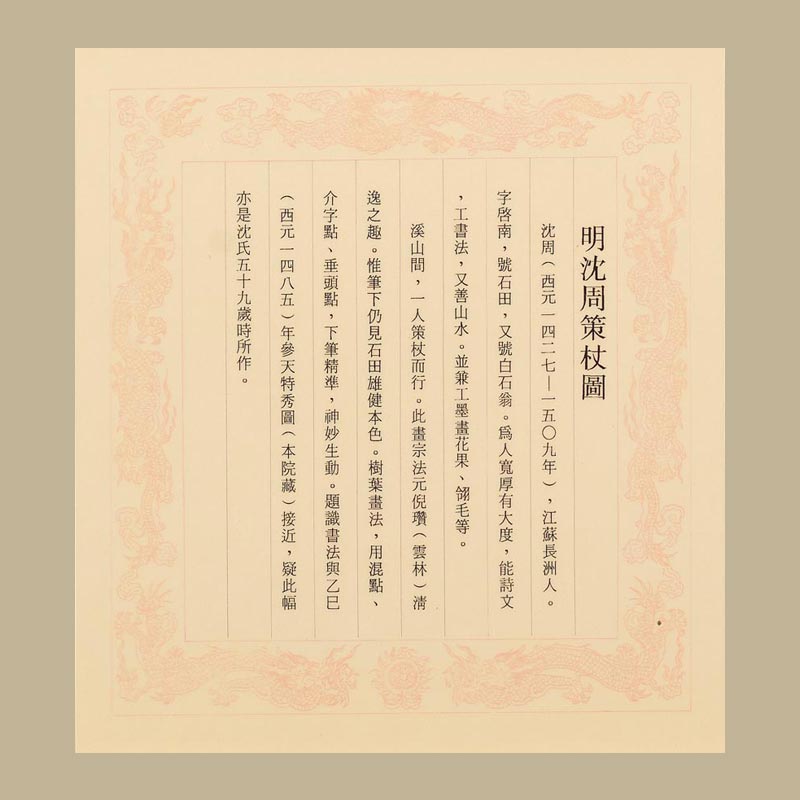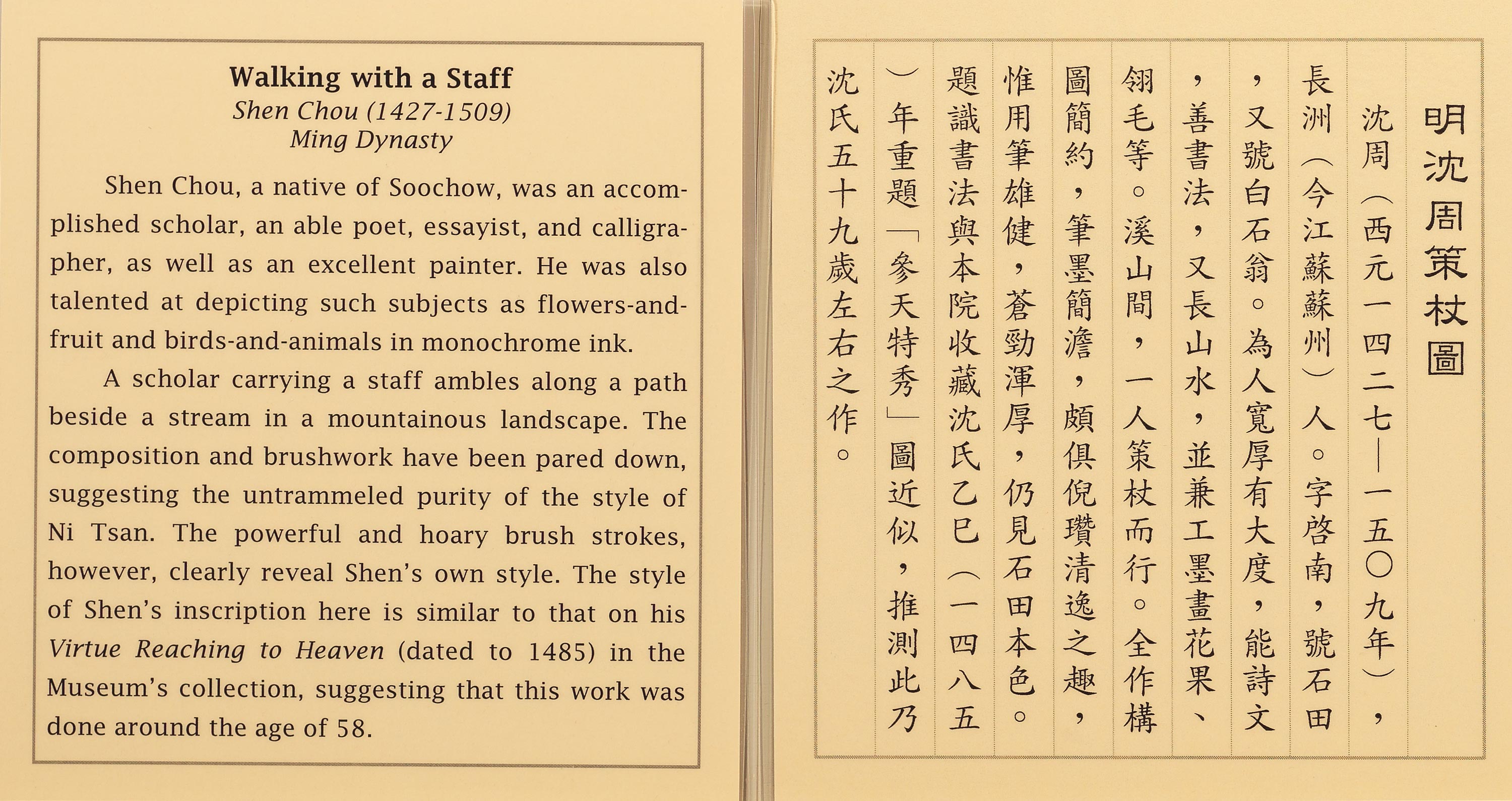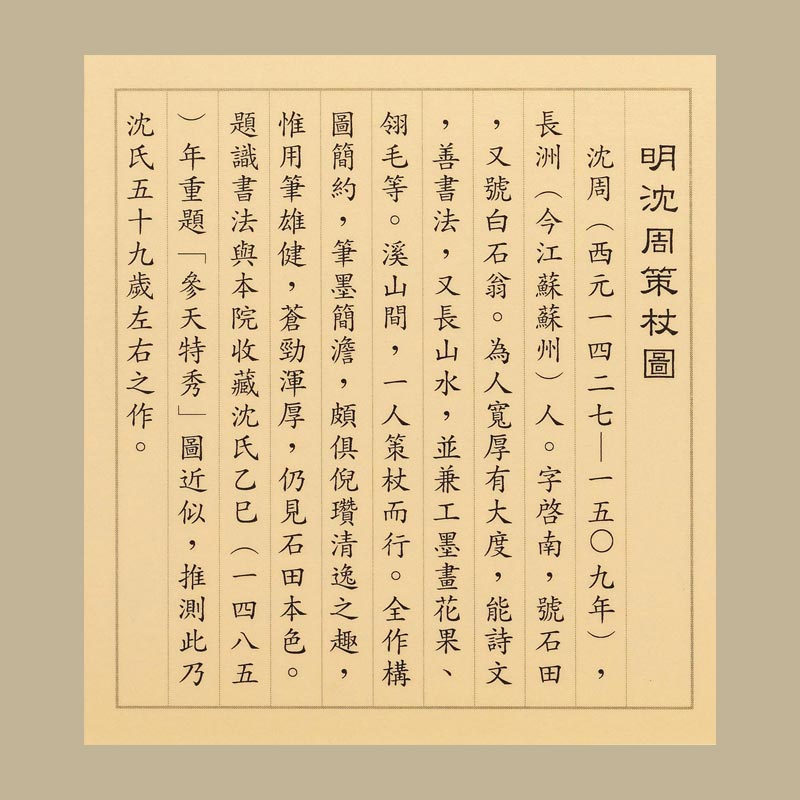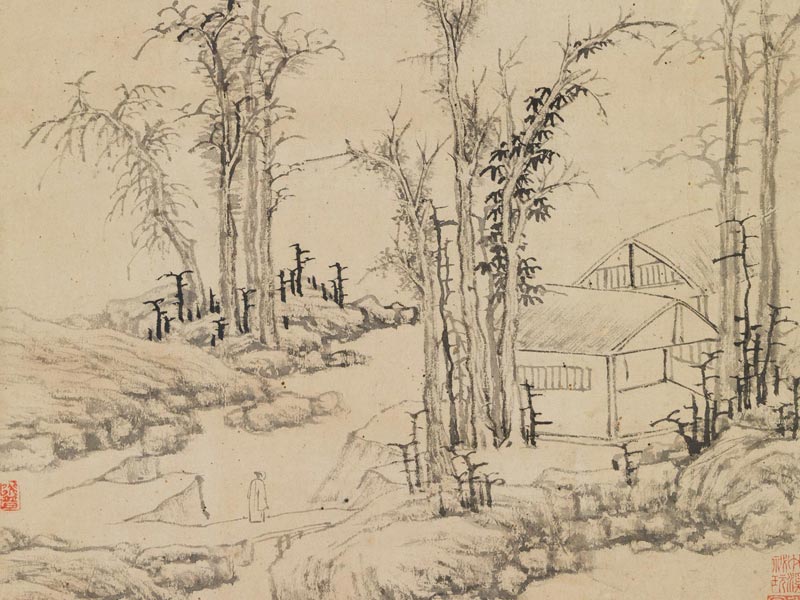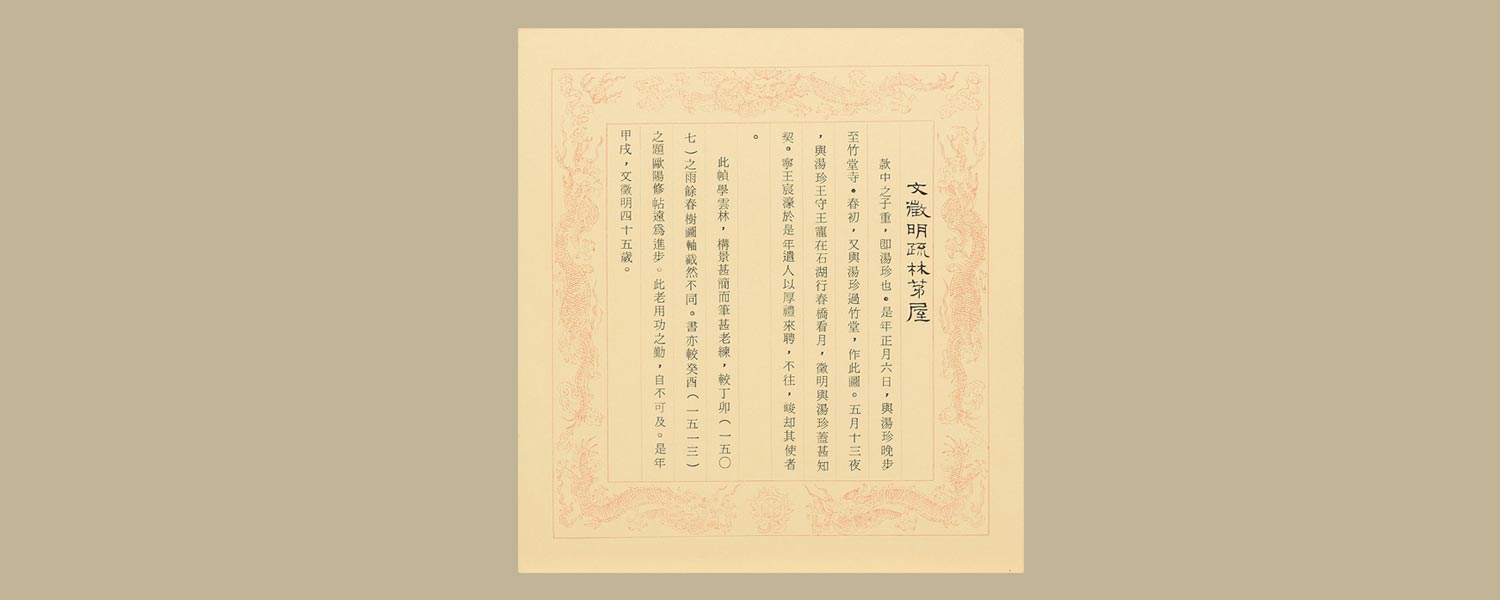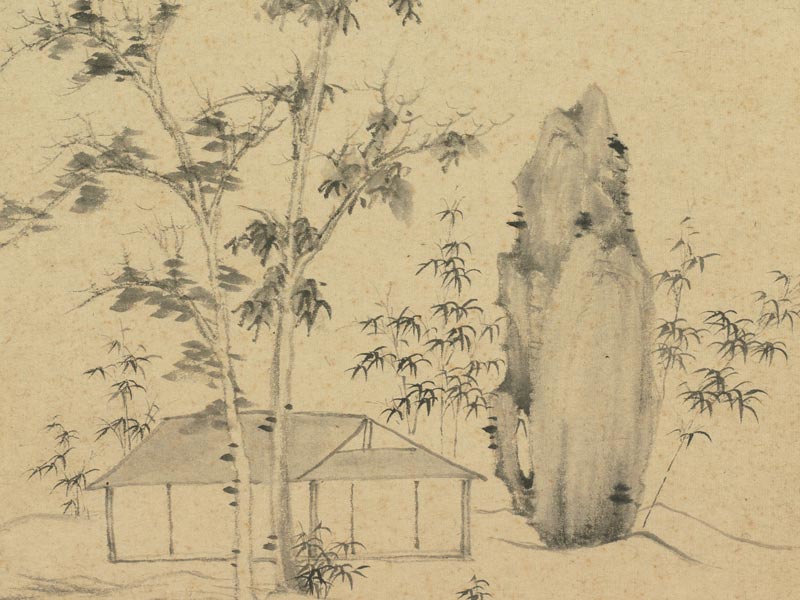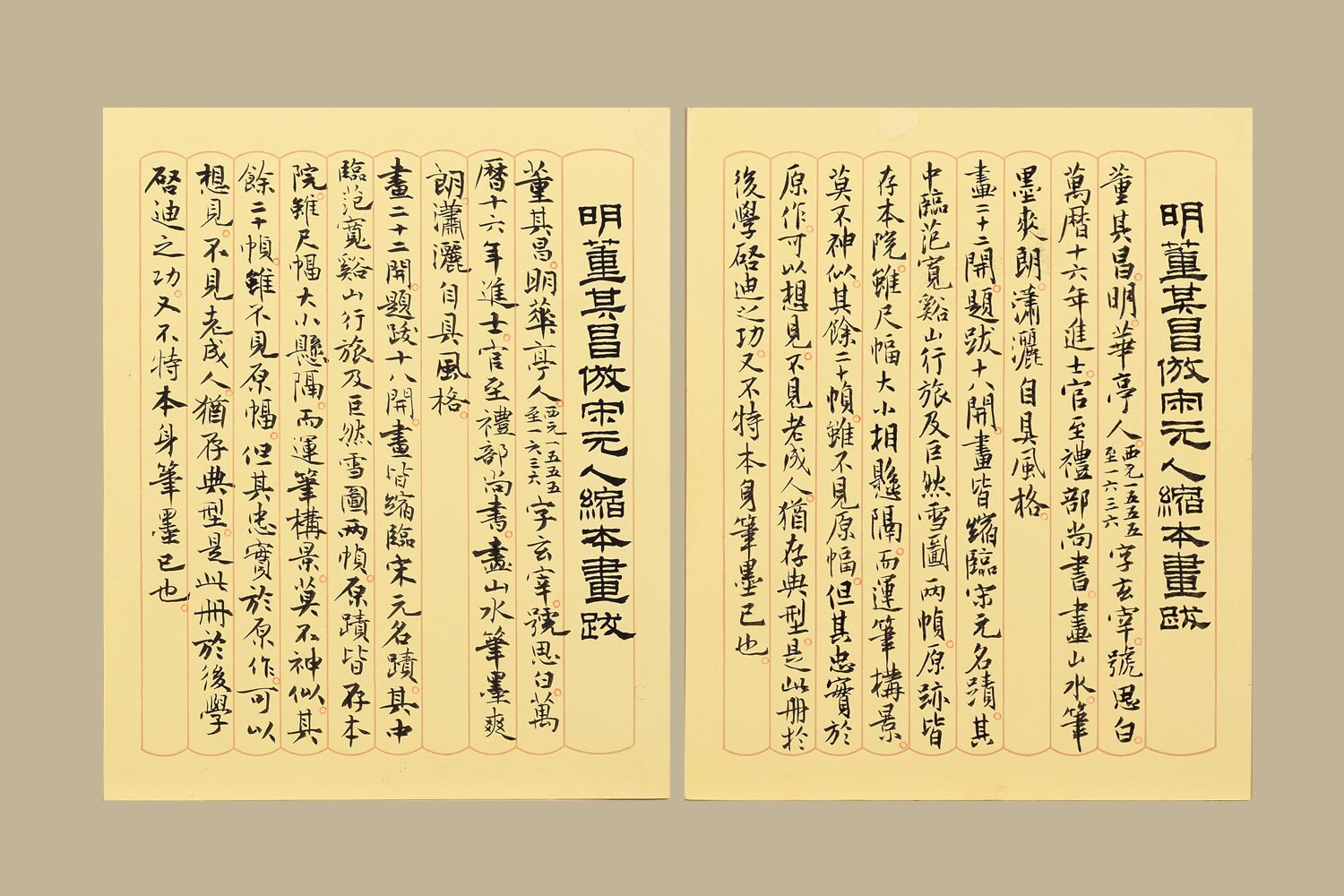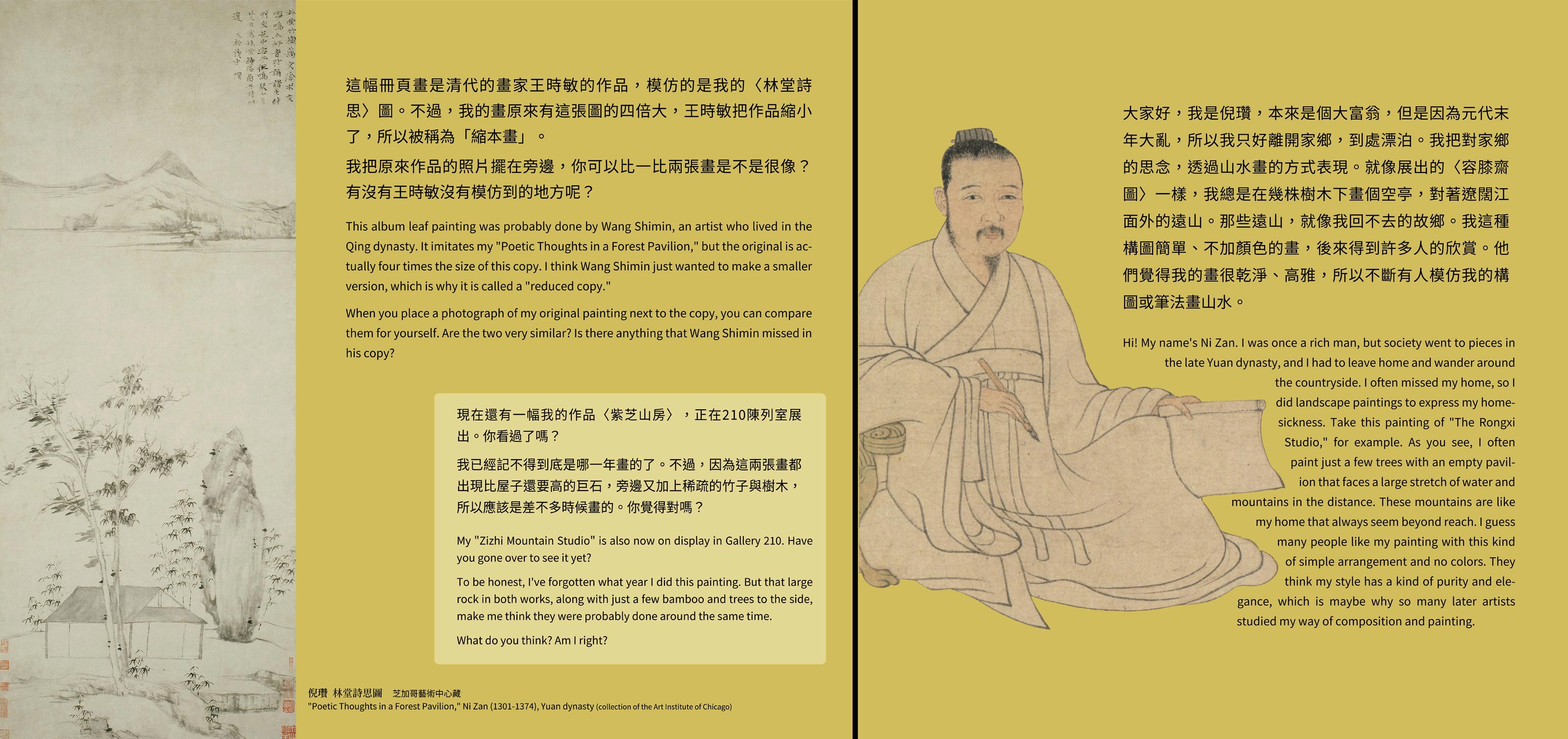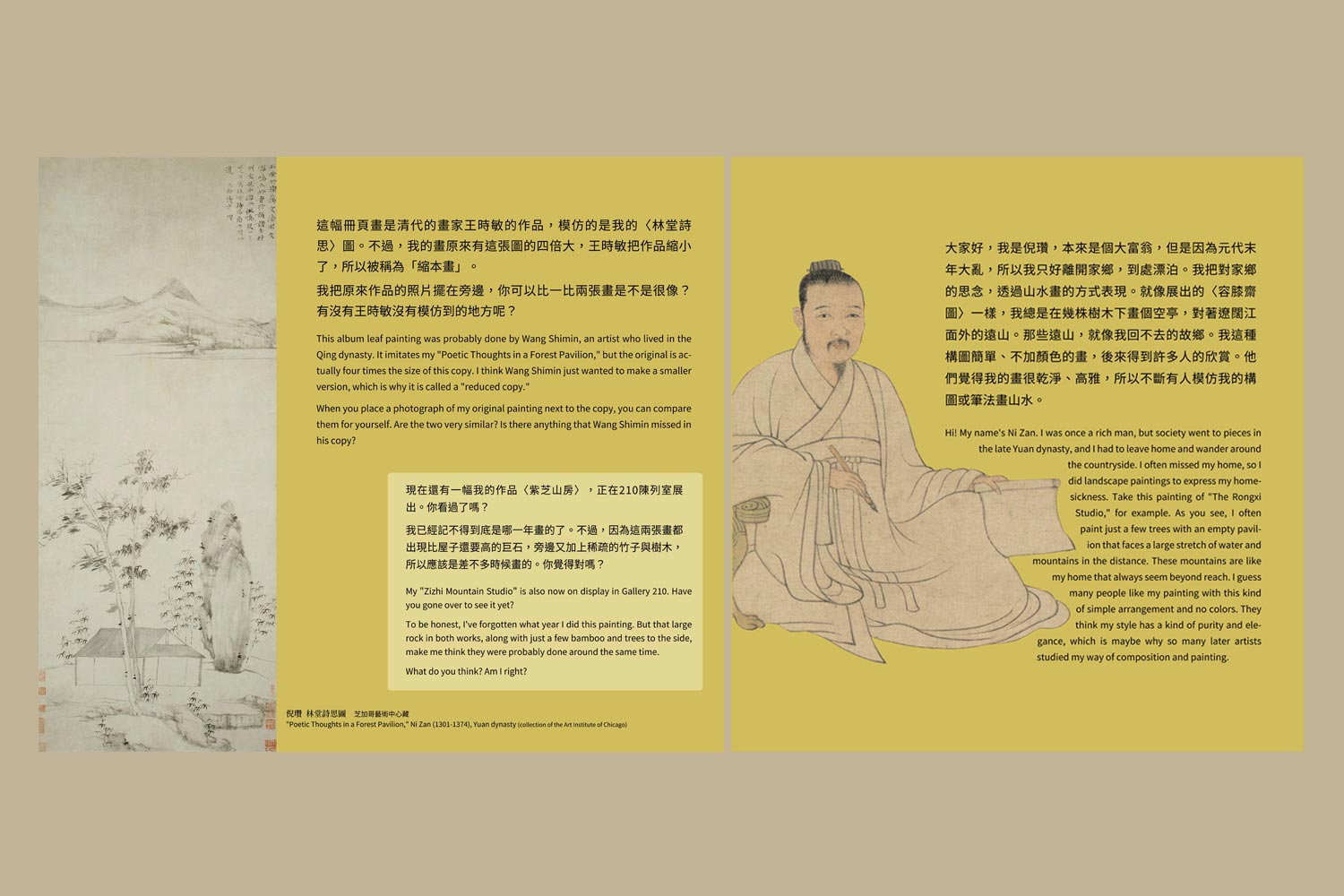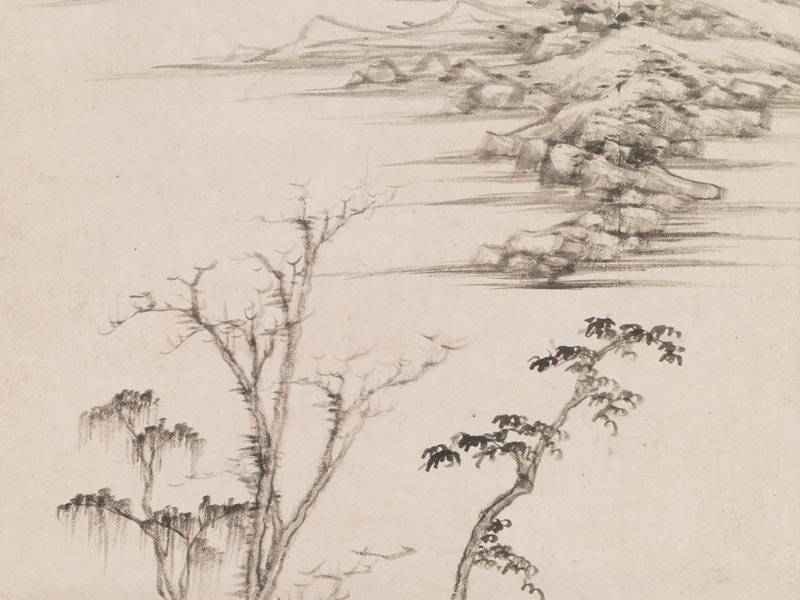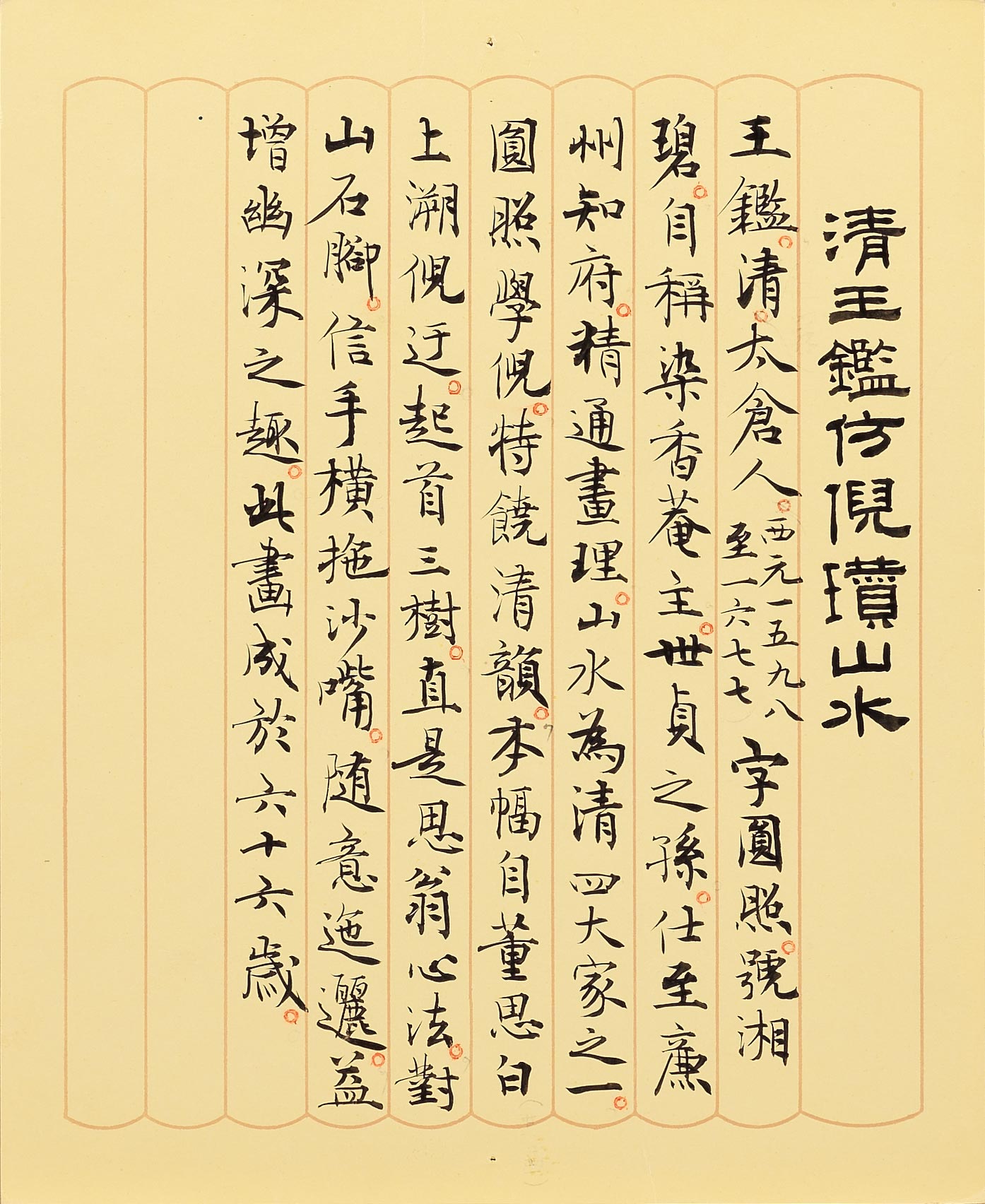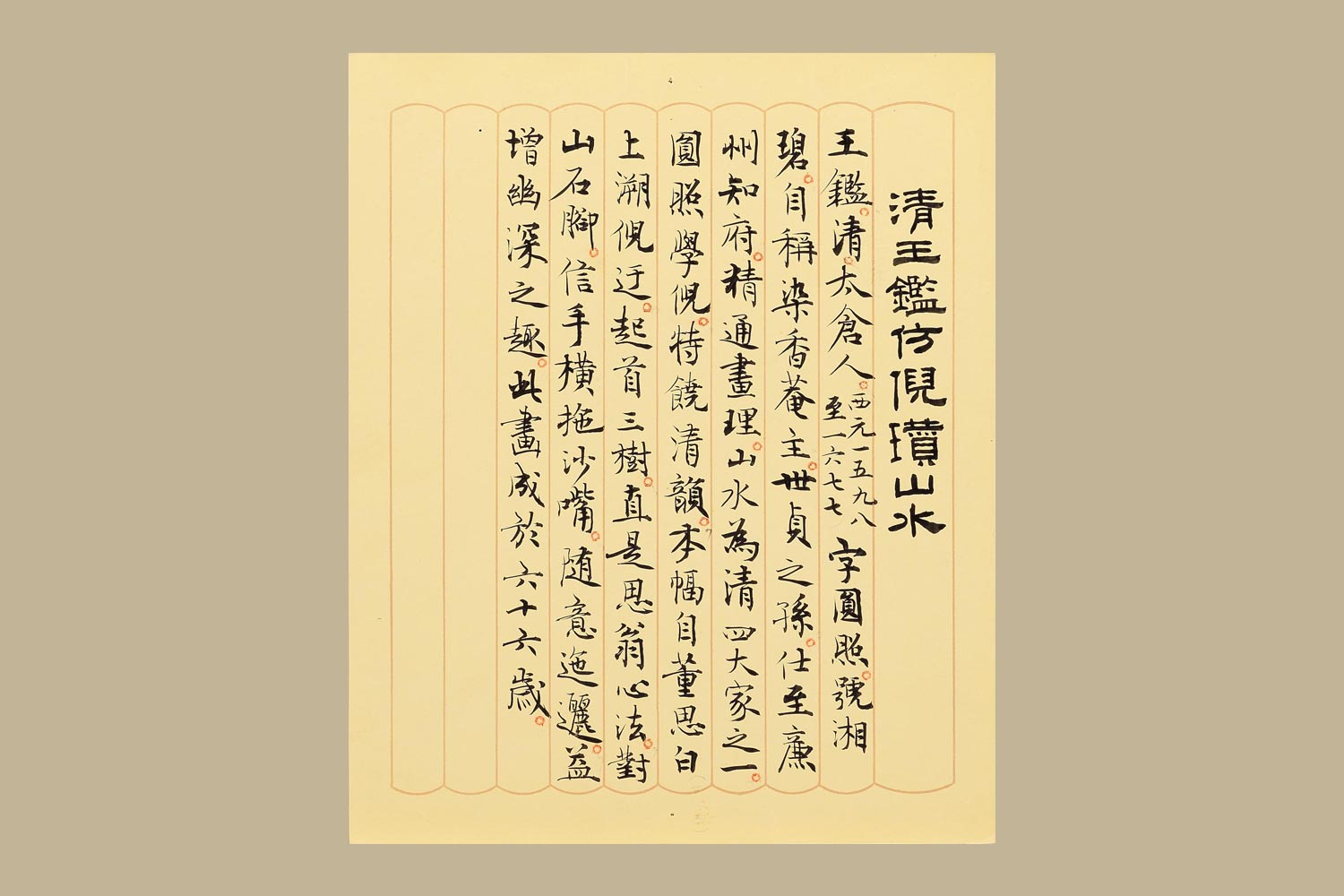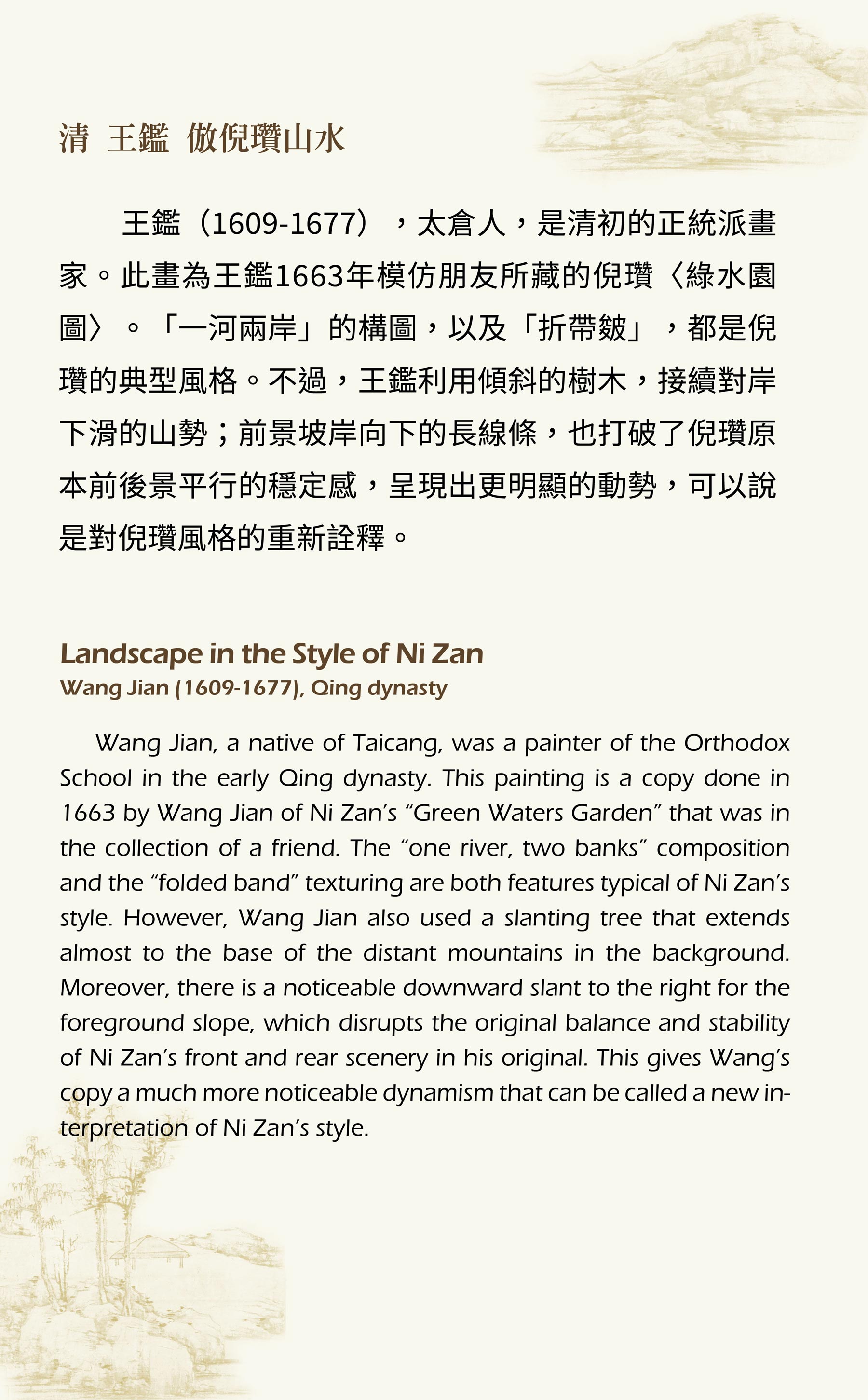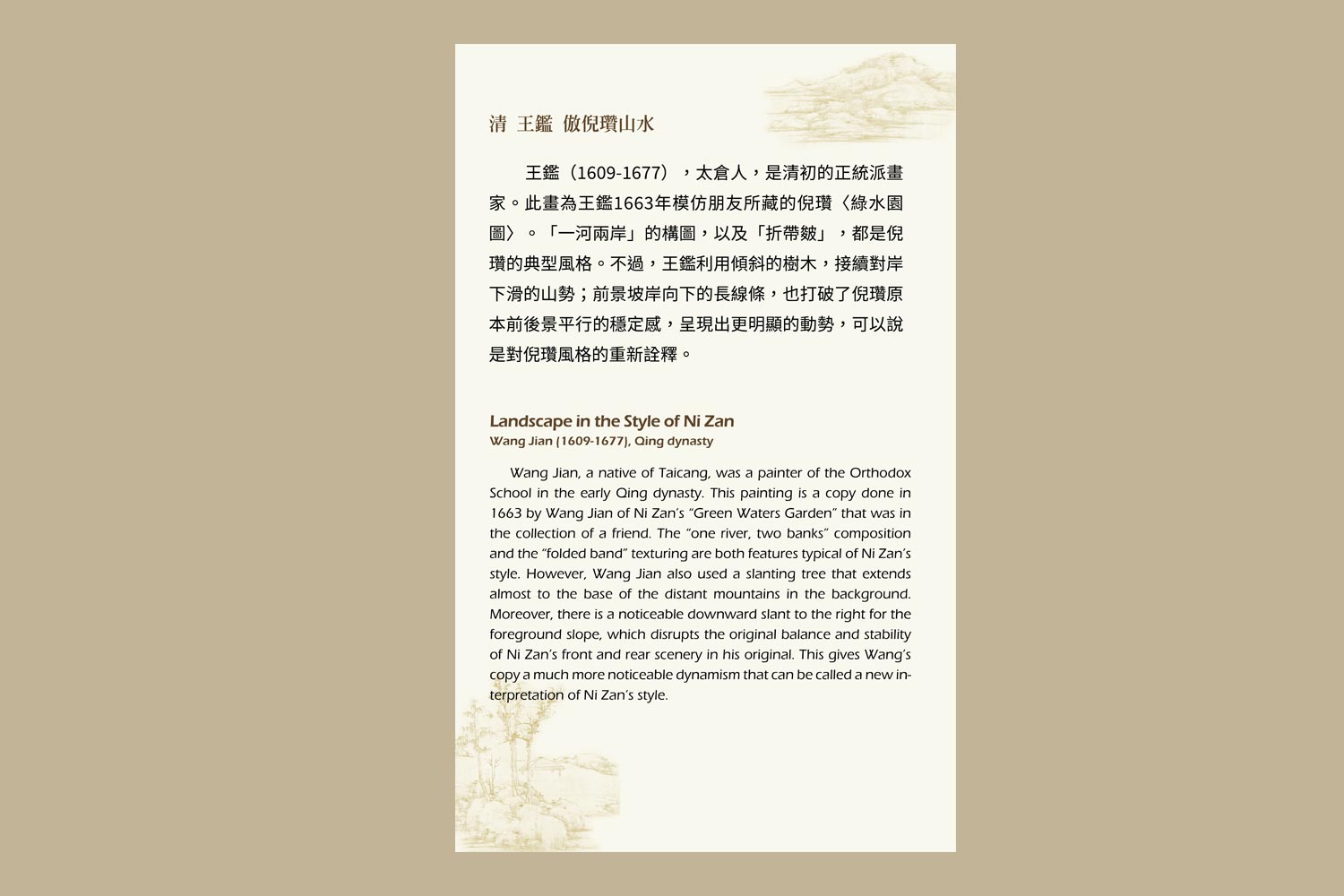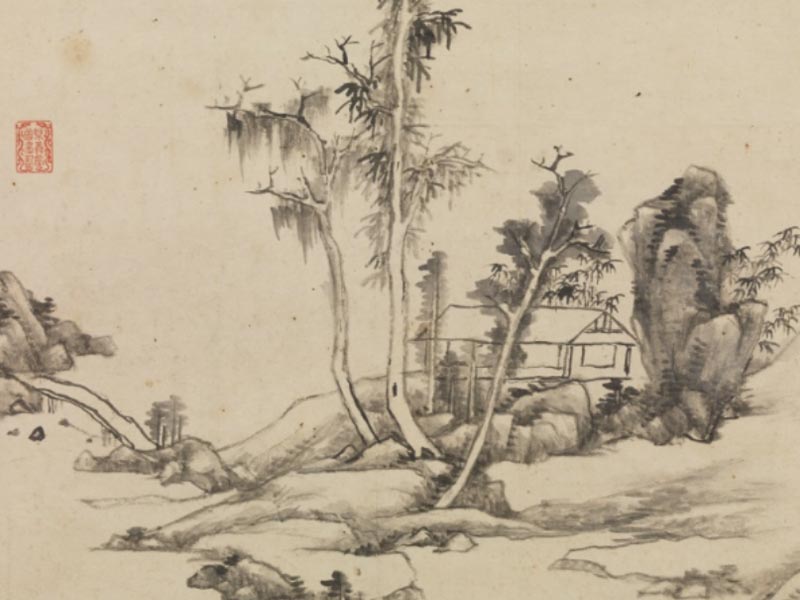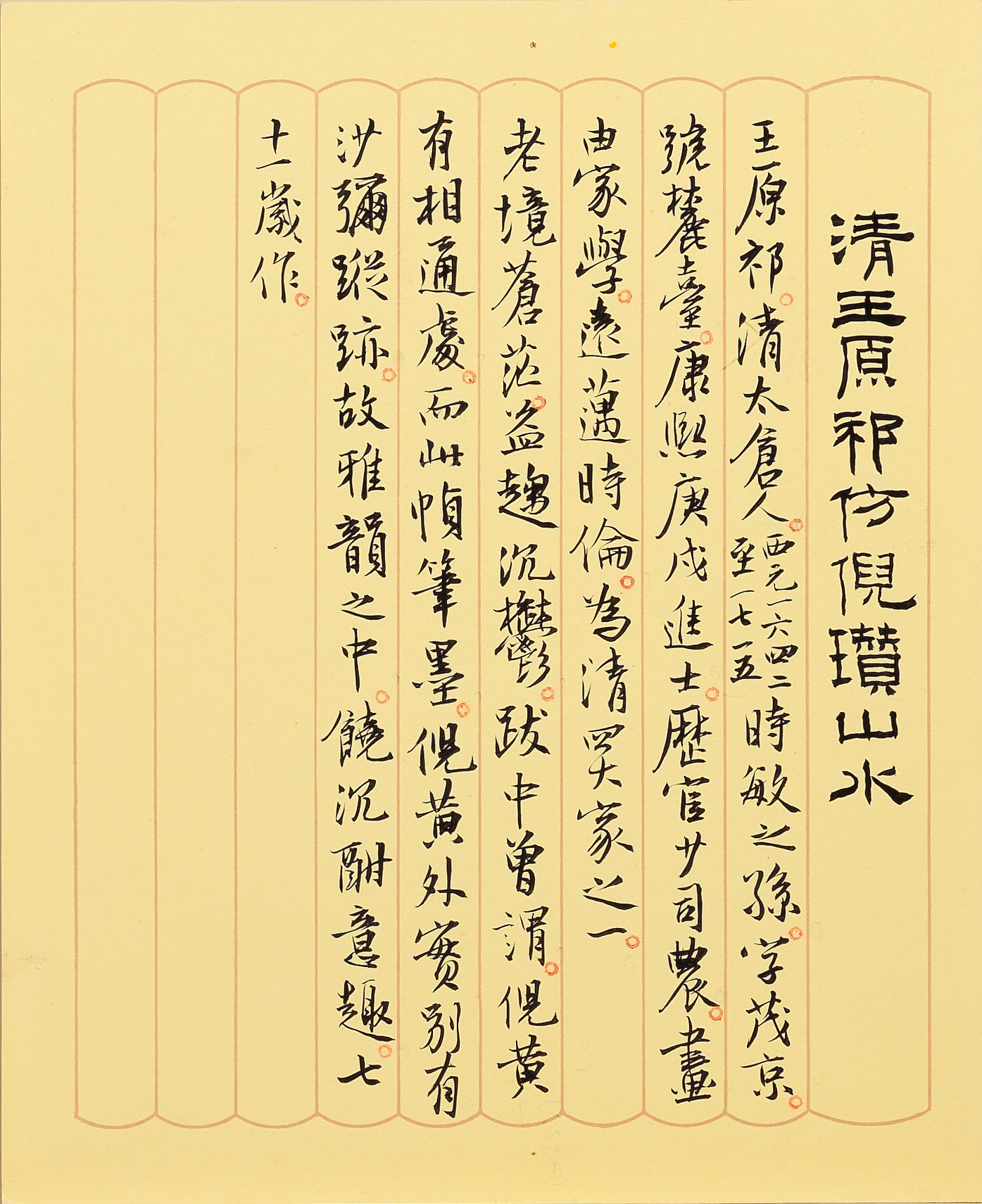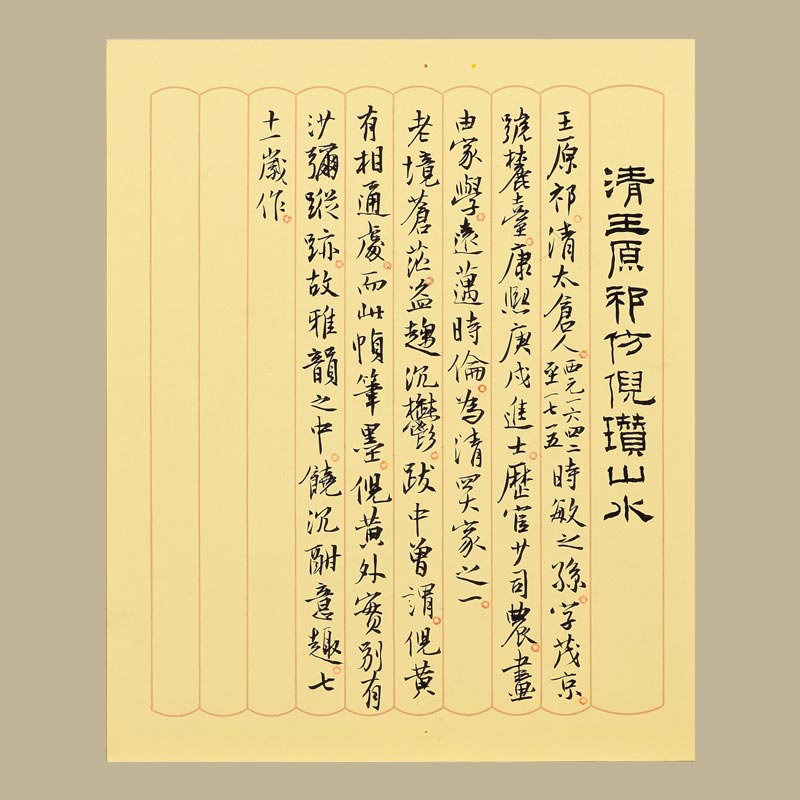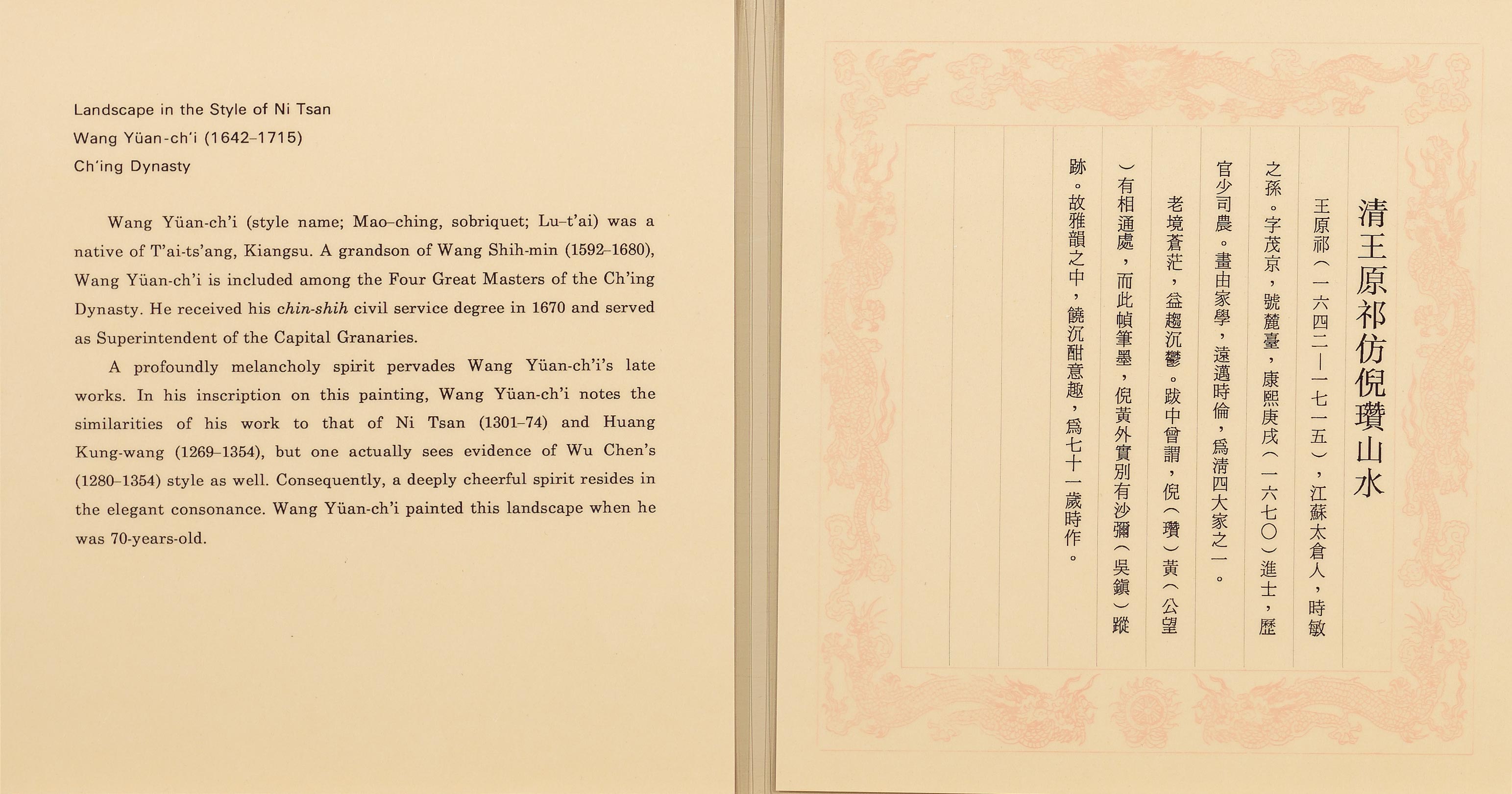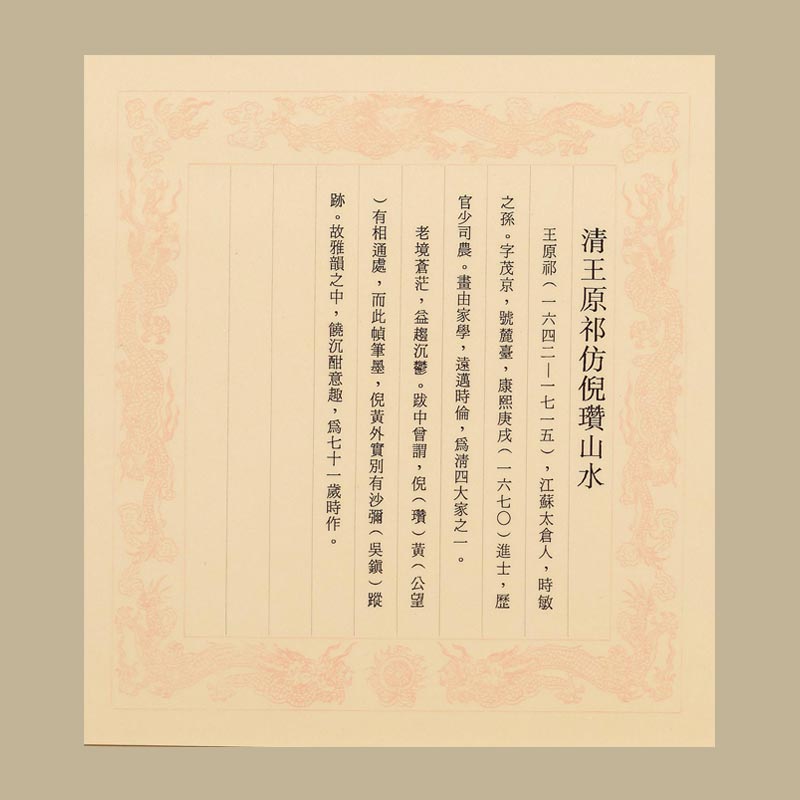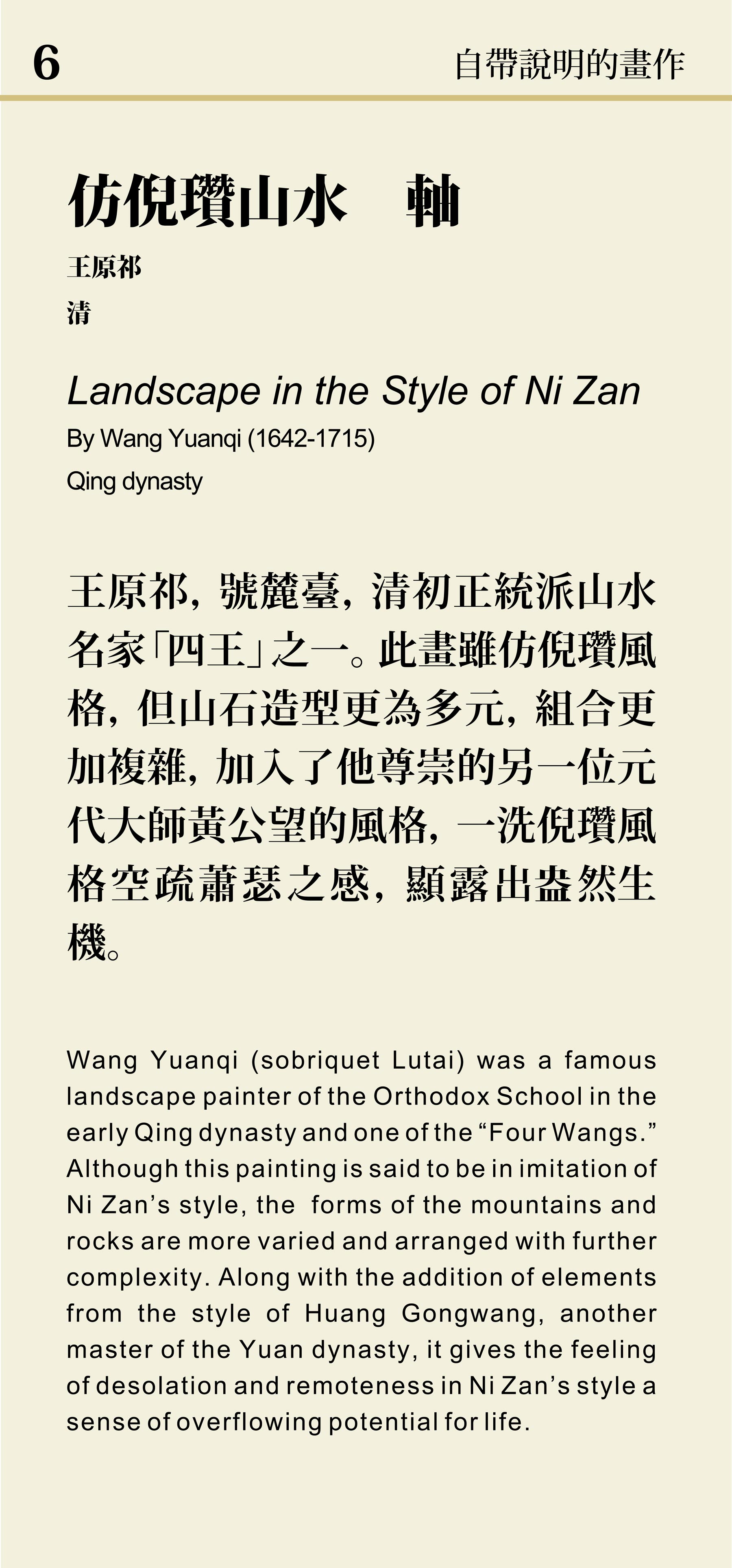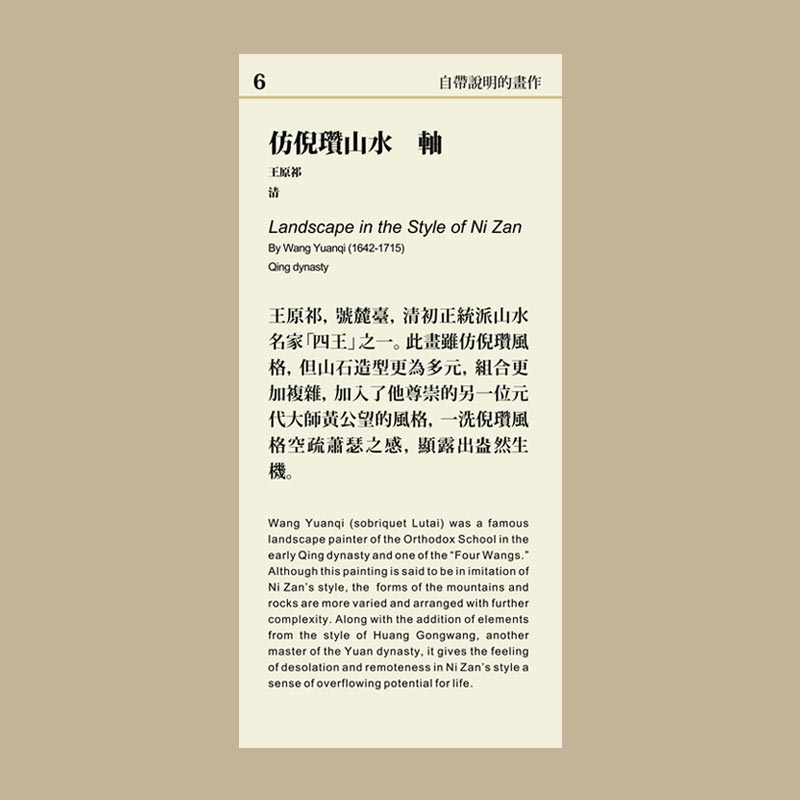Paintings on Display and Their Museum Labels
-
1. The Rongxi Studio
- Ni Zan (1301-1374), Yuan dynasty
Ni Zan (style name Yunlin) originally came from a wealthy family. However, social chaos and turbulence in the late Yuan dynasty forced him to lead a life of wandering in the Lake Tai area. Ni originally did this painting at the age of 72 for his friend Bixuan. Two years later, Bixuan wanted to gift this work to a common friend of theirs, a doctor named Pan Renzhong. For that occasion, Bixuan asked Ni Zan to write some poetry on the painting. Since Ni Zan's inscription mentions Pan's residence as "Rongxi Studio," this instead became the title of the painting.
In this hanging scroll, Ni Zan uses the "one river, two banks" compositional approach to arranging the landscape. Rather than emphasizing the design of exotic or grand mountain forms, he instead creates a mystical sense of ethereal space. The balanced layering of light ink tones combined with hooked and washed texture strokes as well as the balance of solid and void that balance each other in the arrangement here form the aesthetic tendencies of Ni Zan's style. He created a pure and elegant desolation in painting that would ultimately become a paradigm for later generations to venerate and imitate.
This masterpiece of Ni Zan's late years was verified and declared by the Executive Yuan's Council of Cultural Affairs (forerunner of the Ministry of Culture) as a "National Treasure" on December 24, 2008. -
2. Scattered Trees and Distant Mountains
- Attributed to Ni Zan (1301-1374), Yuan dynasty
Ni Zan (style name Yuanzhen, sobriquets Yunlin and Yuweng) was from Wuxi, Jiangsu. From a wealthy family, his collection of art was stored at the Qingbi Pavilion. Ni Zan excelled at painting landscapes and was considered one of the Four Yuan Masters. With shades of ink, Ni Zan has depicted here a river bank on which a sparse grove of trees and bamboo are clustered around a simple cottage. On the opposite shore, a series of peaks rise. Executed mostly with a centered brush, the texturing of the trees and rocks was largely done with hemp-fiber strokes; some slanted strokes and dots also appear. The inscription on this work done in 1372, however, is actually copied from that of Ni Zan's "Rongxi Studio," also in the Museum's collection, which is considered genuine. The brushwork here furthermore lacks the powerful force of the master, suggesting it is a later copy.
-
3. Walking with a Staff
- Shen Zhou (1427-1509), Ming dynasty
Shen Zhou (sobriquet Shitian) used the brush in a simple and straightforward manner, achieving an effect slightly different from the lofty elegance found in that of Ni Zan (sobriquet Yunlin). Among the works attributed to Shen Zhou done in imitation of Ni Zan's style, Shen would go beyond that of his model. For an album by Shen Zhou, Dong Qichang once wrote that "Shen Qi'nan (Zhou) was the best among those following the Four Yuan Masters, being exceptionally gifted at reaching beyond Lofty Ni in the study of his style." Thus, in terms of tranquil untrammeledness, Shen was no match for Ni. But as for simple straightforwardness, Shen actually surpassed him. For this reason, Shen's study of Ni's painting has a boundless atmosphere within the elegant tranquility. A desolate cold pervades the entire paper of this work, making it a masterpiece of imitating Ni Zan's painting.
-
4. Thatched Cottage Among Scattered Trees
- Wen Zhengming (1470-1559), Ming dynasty
"Zichong" in the signature here refers to Tang Zhen. On the sixth day of the first lunar month, Wen Zhengming took a late walk to the Bamboo Hall Temple with Tang Zhen. Then, in early spring, he did this work at Tang Zhen's Passing Bamboo Hall. Afterwards, on the evening of the thirteenth day of the fifth lunar month, he gathered with Tang Zhen, Wang Shou, and Wang Chong to view the moon at the Traveling-in-Spring Bridge at Stone Lake, demonstrating the like-minded close friendship of Wen and Tang. In fact, when Zhu Chenhao, the rebel Prince of Ning, dispatched someone to invite Wen to join him for a large sum, he did not go, demonstrating his lofty ideals.
This painting is patterned after Ni Zan's style, the scenery quite simple and the brushwork very mature, making it somewhat different from Wen's "Spring Trees After Rain" done in 1507. The calligraphy, however, is far superior to the inscription Wen did for a work of calligraphy by Ouyang Xiu dated to 1513. Such diligence at an old age is something that even the author cannot match! That year was 1514, when Wen Zhengming was 45 by Chinese reckoning -
5. From "Album of Reduced Copies in Imitation of Song and Yuan Paintings with Colophons"
- Dong Qichang (1555-1636), Ming dynasty
The frontispiece to this set of album leaves features four large characters calligraphed by Dong Qichang that read, "Within the Small, the Large is Revealed." This title was originally for Dong Qichang's own paintings, but according to research in recent years, the album leaves here were probably done by Wang Shimin.
This album leaf painting is in imitation of Ni Zan's "Poetic Thoughts in a Forest Pavilion," a work done in his later years. The original, now in the collection of the Art Institute of Chicago, is four times larger than the album leaf copy. Since Wang Shimin reduced the dimensions of the original to fit into this album leaf, it is called a "reduced copy." In an age before the advent of photography, such reduced copies preserve the appearance of larger originals, making them exceptionally refined reproductions. -
6. Landscape in the Style of Ni Zan
- Wang Jian (1598-1677), Qing dynasty
Wang Jian, a native of Taicang, was a painter of the Orthodox School in the early Qing dynasty. This painting is a copy done in 1663 by Wang Jian of Ni Zan's "Green Waters Garden" that was in the collection of a friend. The "one river, two banks" composition and the "folded band" texturing are both features typical of Ni Zan's style. However, Wang Jian also used a slanting tree that extends almost to the base of the distant mountains in the background. Moreover, there is a noticeable downward slant to the right for the foreground slope, which disrupts the original balance and stability of Ni Zan's front and rear scenery in his original. This gives Wang's copy a much more noticeable dynamism that can be called a new interpretation of Ni Zan's style.
-
7. Landscape in the Style of Ni Zan
- Wang Yuanqi (1642-1715), Qing dynasty
Wang Yuanqi (sobriquet Lutai) was a famous landscape painter of the Orthodox School in the early Qing dynasty and one of the "Four Wangs." Although this painting is said to be in imitation of Ni Zan's style, the forms of the mountains and rocks are more varied and arranged with further complexity. Along with the addition of elements from the style of Huang Gongwang (1269-1354), another master of the Yuan dynasty, it gives the feeling of desolation and remoteness in Ni Zan's style a sense of overflowing potential for life.

